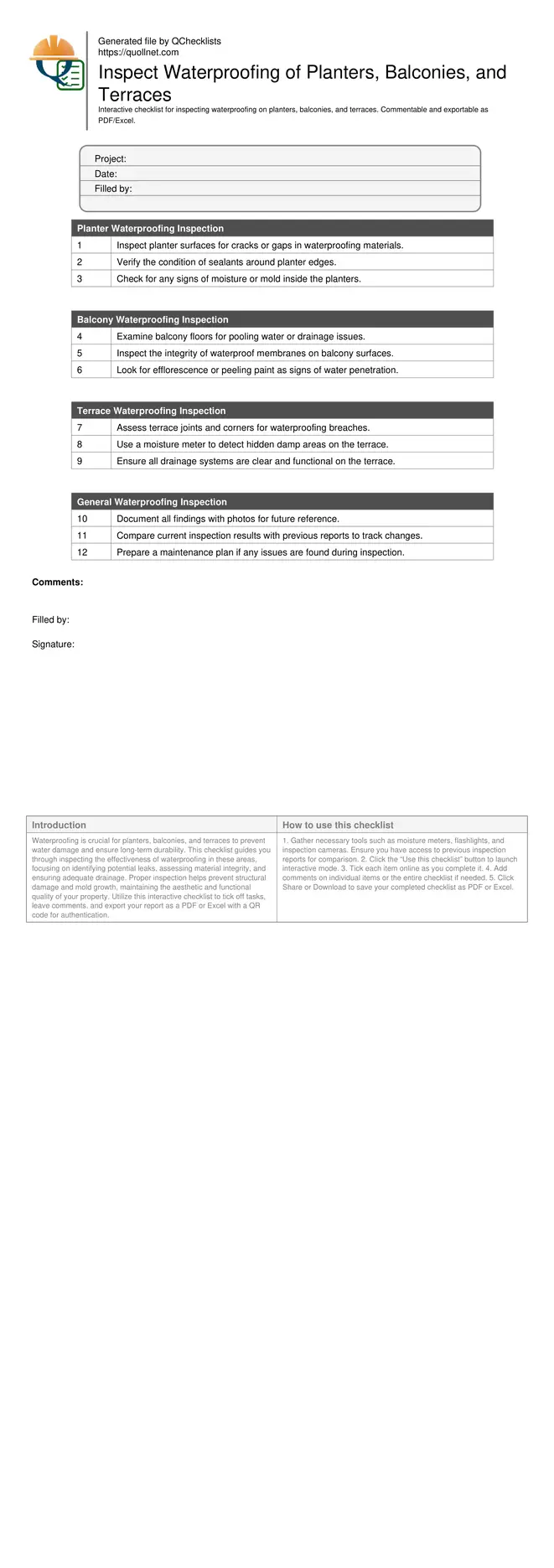Waterproofing Inspection Checklist for Planters, Balconies, and Terraces
Waterproofing is crucial for planters, balconies, and terraces to prevent water damage and ensure long-term durability. This checklist guides you through inspecting the effectiveness of waterproofing in these areas, focusing on identifying potential leaks, assessing material integrity, and ensuring adequate drainage. Proper inspection helps prevent structural damage and mold growth, maintaining the aesthetic and functional quality of your property. Utilize this interactive checklist to tick off tasks, leave comments, and export your report as a PDF or Excel with a QR code for authentication.
- Ensure the longevity of planters, balconies, and terraces by inspecting waterproofing to prevent water damage.
- Identify potential leaks and ensure proper drainage to avoid structural issues and mold growth.
- Maintain material integrity and aesthetic quality with regular waterproofing inspections.
- Interactive online checklist with tick, comment, and export features secured by QR code.
Planter Waterproofing Inspection
Balcony Waterproofing Inspection
Terrace Waterproofing Inspection
General Waterproofing Inspection
Understanding Waterproofing Needs
Waterproofing is an essential component to protect structures from water intrusion. Planters, balconies, and terraces are particularly vulnerable due to their exposure to weather elements. An effective waterproofing system involves assessing materials like membranes and sealants, and ensuring they are applied correctly. Regular inspections help identify potential issues before they escalate.
- Check for cracks and gaps in waterproofing layers.
- Ensure materials used are suitable for all weather conditions.
- Assess the condition of existing waterproofing membranes.
- Look for visible signs of water penetration or mold.
- Confirm that sealants are intact and effective.
Inspection Techniques
A thorough inspection of waterproofing involves assessing the integrity of materials and the effectiveness of applications. Use tools like moisture meters to detect hidden dampness, and observe visible signs like efflorescence or peeling paint. Document any findings and compare them against previous inspections to determine any deterioration.
- Use moisture meters to identify hidden dampness.
- Inspect for efflorescence as a sign of water ingress.
- Look for peeling or bubbling paint as a symptom of underlying issues.
- Document findings with photos for future reference.
- Compare current conditions with past inspection reports.
Common Mistakes to Avoid
Avoiding common mistakes during waterproofing inspections can save time and resources. Overlooking minor cracks or failing to check the compatibility of materials can lead to significant water damage over time. Ensure all areas, including corners and joints, are thoroughly inspected and that any repairs are done using compatible materials.
- Don't overlook small cracks or gaps.
- Ensure materials are compatible with each other.
- Thoroughly inspect corners and joint areas.
- Avoid using incompatible repair materials.
- Regularly update inspection and repair records.
How to Use This Checklist
- Gather necessary tools such as moisture meters, flashlights, and inspection cameras. Ensure you have access to previous inspection reports for comparison.
- Click the “Use this checklist” button to launch interactive mode.
- Tick each item online as you complete it.
- Add comments on individual items or the entire checklist if needed.
- Click Share or Download to save your completed checklist as PDF or Excel.
Call to Action
- Start Checklist Tick off tasks, leave comments on items or the whole form, and export your completed report to PDF or Excel—with a built-in QR code for authenticity.
- Download Excel - Inspect Waterproofing of Planters, Balconies, and Terraces
- Download PDF - Inspect Waterproofing of Planters, Balconies, and Terraces
- View Image - Inspect Waterproofing of Planters, Balconies, and Terraces
